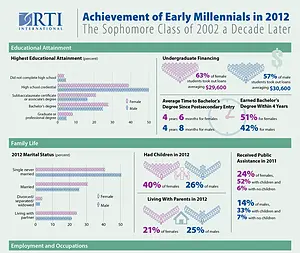Tracking milestones to adulthood for students who were high school sophomores in 2002
Students’ journeys from high school to postsecondary education vary widely. For some, the trajectory from high school to college is a straight shot. For others, a special interest or circumstance may lead them to a community college or technical school, while some young people may feel most comfortable wetting their feet at a certificate program.
Regardless of their decisions, certain societal assumptions are often made about those students who do well academically and achieve college degrees. For example, strong high school preparation leads to college success, and completion of a bachelor’s or advanced degree leads to higher employability and earnings. But how do we know that these trajectories haven’t changed since the 2007 Great Recession? How are we sure college success and advanced degrees pay off in better jobs and higher salaries?
Fact-checking these assumptions are the results of one longitudinal study of students moving from high school, to college, and then on to jobs, marriages, and families.
The Institute of Education Science’s National Center for Education Statistics commissions such studies to determine which factors play a role in the shaping of young adults. By observing the outcomes of these students’ activities and decisions, RTI’s researchers established relationships between the core milestones of young adulthood.
“Early Millennials” study followed the students who were high school sophomores in 2002 over a decade, looking at their educational attainment, job prospects, marital status, and family creation. Born in the mid-1980s, members of the 2002 sophomore cohort grew up in a tumultuous period of recent history. The “dot-com bubble” of 1997–2000 burst just as most were entering high school. The terrorist attacks of September 11, 2001, occurred when these students had just started their sophomore year in high school. When the Great Recession hit in 2007–08, most cohort members were turning 22 years old, and many were in college or finishing postsecondary certificates or degrees. The economic conditions during the recession contributed to rising unemployment rates, declining earnings, and a growing number of individuals living in poverty—rendering the landscape a difficult terrain for these young adults in the cohort as they were entering the workforce.
In addition to their place in the larger historical context, 2002 high school sophomores came of age during a period of change in postsecondary education. While the decades prior had witnessed an upward trend in postsecondary enrollment and attainment, the same years also brought a skyrocketing cost of attending college. In today’s market, many young people need to borrow money to pay for postsecondary education and leave school with high levels of debt. Some experts fear such debt will undermine students’ abilities to pursue further education, start families, and achieve financial independence.
Ten Years of Development in Context
The study began with a nationally representative sample of 15,000 high school sophomores from both public and private schools across the country. Over the next decade, these individuals were resurveyed three times, in 2004, 2006, and 2012. The last check-in coincided with an important period of development for the cohort, most of whom were 26 years old in 2012 and had been out of high school for eight years.
The study’s check-ins addressed the following questions:
- Where did the 2002 sophomores stand 10 years later in terms of education, the labor market, and family formation?
- Did the sophomores from different demographic backgrounds and with different academic characteristics in high school achieve the same or different outcome in those areas?
- Did various demographic and high school characteristics have unique associations with 2002 sophomores’ later outcomes in education and the labor market when other factors were taken into account?
By the time they reached their mid-20s in 2012, most of the cohort (96 percent) had completed high school, either traditionally, through a GED, or high school equivalency. Many of the cohort members (82 percent) had gone on to postsecondary education. In 2012, about half of the cohort had earned a postsecondary degree or certificate, a third had attained a bachelor’s or higher degree. Most of the group had entered the workforce, with 82 percent employed, and 11 percent unemployed but looking. The remaining 7 percent of the students surveyed reported being out of the labor force, meaning they were neither working nor looking for work.
Regarding the creation of a family, 28 percent of the cohort had married, with 3 percent divorced, separated, or widowed as of 2012. A third of the cohort members became parents by 2012, while a little less than a quarter of the cohort (23 percent) still lived with their parents.
To measure the various achievements of these milestones among subgroups in the cohort, RTI’s researchers selected three 2012 outcomes—highest educational attainment, employment status, and hourly wages—and used multivariate techniques to examine subgroup differences after controlling for other factors.
Differences and Commonalities Revealed, Gender Plays Key Role
The analyses did not reveal a significant difference in educational attainment for students from various racial and ethnic subgroups compared to their white counterparts, after controlling for gender, family socioeconomic status, native languages, educational expectations, and high school academic experiences. In other words, students of different racial and ethnic groups with similar demographic, socioeconomic, and academic backgrounds had similar probabilities of attaining various degrees of higher education in comparison to their white peers.
The socioeconomic status (SES) of a student’s family had less bearing on employment but a unique relationship with hourly wages. Students from high SES backgrounds tended to earn more hourly than students from lower SES backgrounds, even after controlling for factors like educational attainment, occupation, region, high school performance, etc.
High school preparation is not only associated with college success, but also earnings. The 2002 sophomores graduating from high school with strong academic preparation (e.g., taking calculus and earning a GPA of 3.5 or higher) were more likely to earn a bachelor’s or advanced degree 10 years later, and, if employed, earned higher hourly wages for their 2012 jobs.
One significant finding from the study is that female students in the cohort had higher probability of earning a master’s or other advanced degree than did their male counterparts even after controlling for a range of factors such as race/ethnicity, family SES, high school academic experiences, and educational expectations. Despite higher educational attainment, the females were more likely than males to be unemployed, out of the labor force, or working part-time in 2012, and employed females earned a lower hourly wage than employed males in their 2012 jobs. These gender differences remained significant even after controlling for respondents’ educational attainment, demographic and academic characteristics, current enrollment status, family lives such as martial and parenthood status, and job-related factors such as occupation fields, work intensity, and geographic location. For example, after controlling for these factors, the hourly wage was $16 for employed women and $18 for employed men. In other words, women earn around $2 per hour less than men with the same college degree, working in the same occupational field with the same intensity and in the same geographic area, and with the same marital status and number of children.
The impact of this study is one that furthers our understanding about milestones along the path to achieving adulthood. For example, high school academic preparation has an enduring effect on labor market outcomes. While higher education generally pays off for individuals (i.e., the more education, the higher employability, the better pay), it alone does not ensure equal employment and pay for men and women. Despite outperforming men in postsecondary education, women have not been able to leverage their success in the classroom to success in the labor market. Advocates for women’s education may view the results of the Early Millennials Longitudinal Study with an eye toward examining what elements in addition to education would better prepare young women for job success.
- National Center for Education Statistics


